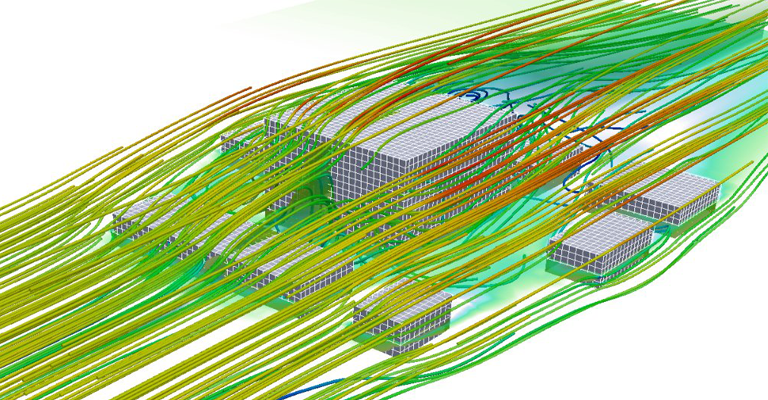As worldwide temperatures rise, global weather patterns are following suit. Wind, or wind power, is one of the most critically affected factors of changing weather patterns. While global warming has some experts hypothesizing that wind strength across the world will decrease, others claim it will intensify in the Southern hemisphere while weakening in the Northern, along with various other schools of thought. As it is still too soon to determine the true consequences of global warming, wind pattern changes are already upon us. This poses a number of problems including decreasing the amount of power generated by wind farms, along with increasing conscientious construction of buildings that are experiencing fluctuating wind velocities. As this problem progresses, wind engineering, through wind analysis, is becoming an extremely important consideration for engineers, city planners, and architects alike. In this article, we will discuss how wind simulation through SimScale allows engineers to employ cloud-based CFD as a wind simulator for a range of applications.
Wind Analysis Guide What Is Wind Engineering? Or CWE?
Computational wind engineering (CWE) wind simulation from SimScale Wind engineering combines structural and mechanical engineering with meteorology and applied physics to study the effects of wind. Through analyses, the behavior and consequences of wind force can be evaluated in both the natural and built environments in urban landscapes and beyond.
Virtual Wind Study What is Computational Wind Engineering?
Part of computer-aided engineering technology, computational fluid dynamics (CFD) harnesses the power of online simulation to analyze wind effects. This type of wind engineering combines wind and thermal comfort with fluid mechanics to ensure livable conditions for inhabitants as well as stability and structural integrity for building design in a more efficient methodology.
Wind Analysis How Can Online Wind Simulation Help?
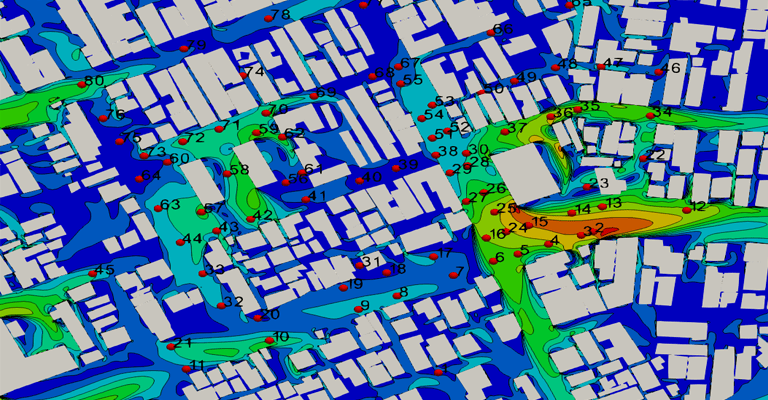
As urban areas become increasingly complex and crowded, modern architectural designs must adapt. Technological advances have allowed for the creation and widespread use of CAE (computer-aided engineering) tools, that in turn allow users to easily design, test, evaluate, and improve their designs online without the need for prototypes or wind tunnel simulation. Online wind simulation significantly aids computational wind engineering and can be used for a range of applications and scenarios.
Online and Offline Wind Simulator What Are Different Types of Wind Analysis?
Wind analysis can include but is not limited to evaluating comfort, wind loading on structures, as well as pollution, and natural ventilation. Below, further explanations and real-life wind evaluations and wind simulations are discussed.
Wind Study: Wind Comfort
Wind comfort, also known as pedestrian wind comfort, is the evaluation of wind effect at a passerby level. Ultimately, it means using CFD as a virtual wind simulator to assess ground-level conditions. Factors included in this assessment range from wind direction and speed to air pollution. Comfort is tested by investigating outdoor climate changes caused by the presence of a building, which has a lasting impact on its surroundings.
This project includes findings from both the field and wind tunnel experiments and uses online wind simulation to validate the CFD results for the Architectural Institute of Japan’s case study. This simulation project is a prime example of how validating results is easier than ever before using online platforms like SimScale and underlying CFD solvers, accentuated by directly comparing wind study findings obtained through other types of experimentation.
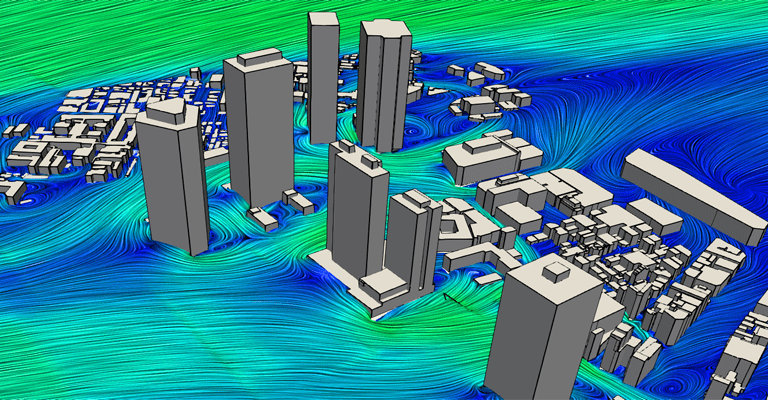
External Wind Analysis: Wind Loading
Wind loading is essentially wind pressure acting upon buildings and structures. This force is most effective when the surface in question provides a flat face and the torsional directions are greater than zero when the wind force in the along-wind direction is a maximum. Wind loading, in turn, impacts the model or natural frequency of a structure, as well as creates vortex shedding that must be evaluated, or otherwise cause vibrations in the building.
This project compares both of these factors, with the intention of mitigating the overlap of wind load frequency and the structure’s frequency response in the design phase through experimentation and iterations.
Internal Wind Analysis: Pollution Control & Natural Ventilation
Air pollution remains a great threat within the built environment and indoor spaces. Ventilation is necessary to prevent this, and wind force is especially powerful in natural ventilation systems. These types of systems rely on air moving through spaces based on air pressure differences and wind power.
This project provides great insights into how wind simulation can be used to determine the best method of pollution extraction. In this particular example, artificial wind is created through ducted ventilation systems, extract fans and jet fan ventilation systems to extract harmful exhaust gases from an underground car park such as Carbon Monoxide (CO), Nitrogen Oxides (NOx) and Sulphur Oxides (SOx) which cause poor air quality. In other online wind study experiments, natural ventilation provides a great alternative to mechanical ventilation simulation and energy-consuming systems.
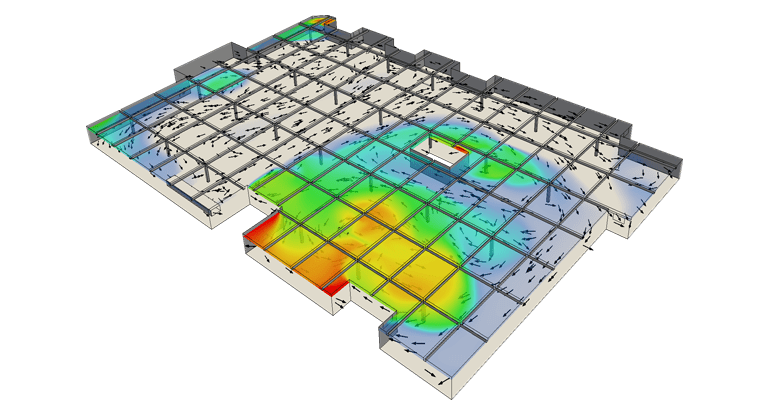
Wind force is a critical factor in natural ventilation systems. This SimScale project assesses the effectiveness of a passive ventilation cooling strategy in a department store while considering the window design and placement. Computational wind engineering is extremely effective when creating designs aimed to control airflow through doors, windows, vents, and other inlets for thermal comfort within buildings.
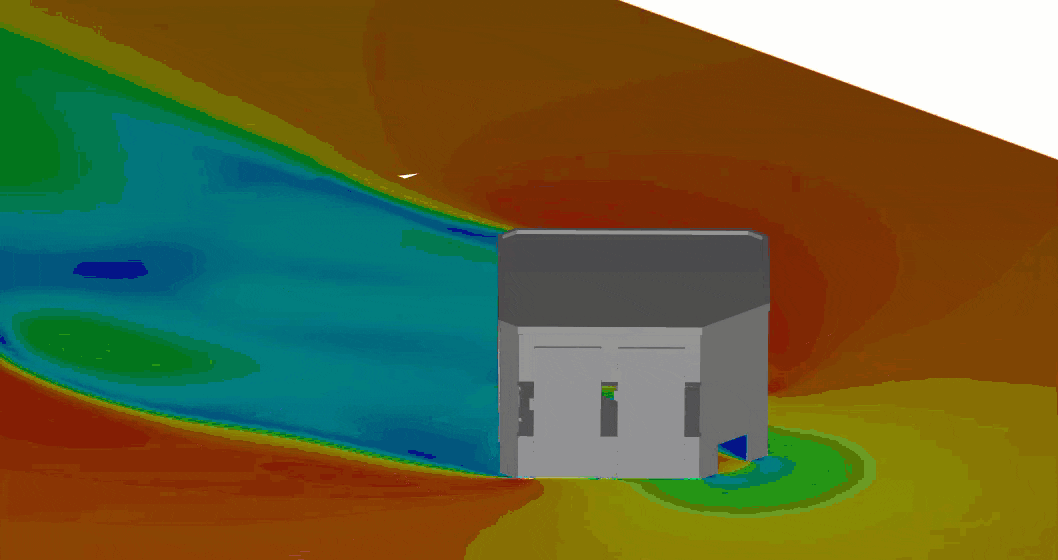
Wind Study What Results Can I Expect From Wind Analysis Experiments?
Using online simulation from SimScale, you can run multiple wind simulations in parallel with our cloud-based platform. This means you can determine if your building design is up to coding standards like ASHRAE 55, if the average wind velocity will negatively interfere with your buildings’ natural frequency, and if the planned structure is safe for pedestrians or creates too much vortex shedding. Due to the nature of the wind study online platform, you can easily adjust and improve your designs for quicker iterations and an overall faster design process than physical prototyping alternatives.
Wind Analysis Guide Other Wind Study Resources from SimScale
- Read about this wind experiment
- Visit our urban microclimate page for more information.
- Check out our wind analysis public project page to get started on your own simulations.
- Read about How to Assess Pedestrian Wind Comfort in 2019.
- Learn about all things wind simulation-related on our blog.
Download our ‘Tips for Architecture, Engineering & Construction (AEC)’ white paper to learn how to optimize your designs!
